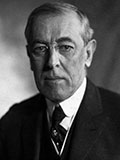

- Schenck v. United States full program
- Justices Scalia and Ginsburg on the First Amendment
- Oliver Wendell Holmes: The Justice from Beacon Hill
- Justice Holmes and the Civil War
- Abrams v. United States
- The Espionage Act of 1917
- Woodrow Wilson and WWI
- WWI Committee on Public Information
- Charles Schenck's Pamphlet
- Oliver Wendell Holmes in the Military
- Holmes and Learned Hand
- Unpublished Dissent by Holmes
- Eugene Debs Silent Video
Schenck v. United States (1919) helped define the limits of the First Amendment right to free speech, particularly during wartime. It created the “clear and present danger” standard, which explains when the consequences of speech allow the government to limit it. In this case, the Court chose to unanimously uphold activist Charles Schenck’s conviction after he distributed leaflets urging young men to resist the draft during World War I.
As general secretary of the Socialist Party in Philadelphia, Schenck prepared leaflets that urged young men to “assert your rights” in the face of conscription. In the midst of the First World War, the U.S. government regarded calls for draft resistance as dangerous to national security. Charles Schenck was arrested under the Espionage Act of 1917, which prohibited “disloyal” acts. He was convicted and appealed to the Supreme Court, arguing that his actions were protected as part of his First Amendment freedom of speech. A wartime Court felt differently and ruled to uphold the Act. Justice Oliver Wendell Holmes, Jr., in this famous opinion, compared Schenck’s actions to “falsely shouting fire in the theatre and causing a panic.” This expression is still widely used as an example of the limits of free speech.

Charles Schenck was a Socialist Party leader who believed that war benefitted the rich at the expense of poor men who were sent to fight. He opposed the draft and claimed that it violated the Constitution. Schenck was sentenced to and served six months in jail.

Oliver Wendell Holmes, Jr. (March 8, 1841 – March 6, 1935) was the Supreme Court justice (1902 – 1932) who wrote the well-known majority opinion in Schenck. Holmes was recognized for his bravery fighting for the Union during the Civil War and was greatly influenced by his military service. The “clear and present danger” test created by Justice Holmes would last for 50 years.

Woodrow Wilson (December 28, 1856 – February 3, 1924) was president of the United States (1913 – 1921) during World War I and believed that American support was critical to victory. He asked Congress to pass the Espionage Act of 1917 to punish people who opposed the war or the draft as disloyal.


